
by Gideon Marcus
Hello, Louie!
Enough talk about Cambodia, Israel, and the Race Problem. How about some happy news for a change?
Satchmo, sometimes known as Louis Armstrong, had a birthday this last Independence Day. The famed trumpter and gravel-throated crooner, known for his ear-splitting smile and breaking racial barriers, has just finished his seventh decade.
"It's awful nice to be breathing on your 70th birthday, let alone feeling in the pink," he observed.

A big tribute was held in Los Angeles' Shrine Auditorium for Armstrong on July 3rd, perhaps the most influential jazz musician since the genre was born. While he did not puff his cheeks to blow his horn (he is still recovering from a kidney infection), he did sing for his audience, joined by a number of fellow jazz greats. Proceeds from the event will go to the Louis Armstrong Statue Fund.
So, happy birthday to New Orleans' favorite son. What a wonderful world.
Hello, Jimmy!
As Galaxy approaches its 20th birthday, I see it has reverted to the format the magazine took back in 1958: it is once again an overlarge bi-monthly (like sister mag IF, which means we essentially get three mags every two months). On the one hand, this makes room for bigger pieces, like the superlative story that headlines this month's issue. On the other hand, it means more room for dross like Heinlein's new serial that taillines the book.
Read on. You'll be grateful I did the screening for you…

Cover by Jack Gaughan
Continue reading [July 6, 1970] The Day After Judgment (August/September 1970 Galaxy)

![[July 6, 1970] The Day After Judgment (August/September 1970 <i>Galaxy</i>)](https://galacticjourney.org/wp-content/uploads/2025/07/700708galaxycover-411x372.jpg)
![[June 4, 1970] Something old, something new (July-August 1970 <i>IF</i>)](https://galacticjourney.org/wp-content/uploads/2025/06/IF-1970-07-Cover-472x372.jpg)

 La Balsa puts to sea.
La Balsa puts to sea. The Ra II under way. Note the tether keeping the stern high.
The Ra II under way. Note the tether keeping the stern high. Suggested by “Time Piece”. Art by Gaughan
Suggested by “Time Piece”. Art by Gaughan![[September 12, 1969] Earthshaking (October 1969 <i>Galaxy</i>)](https://galacticjourney.org/wp-content/uploads/2024/09/690912galaxycover-397x372.jpg)

